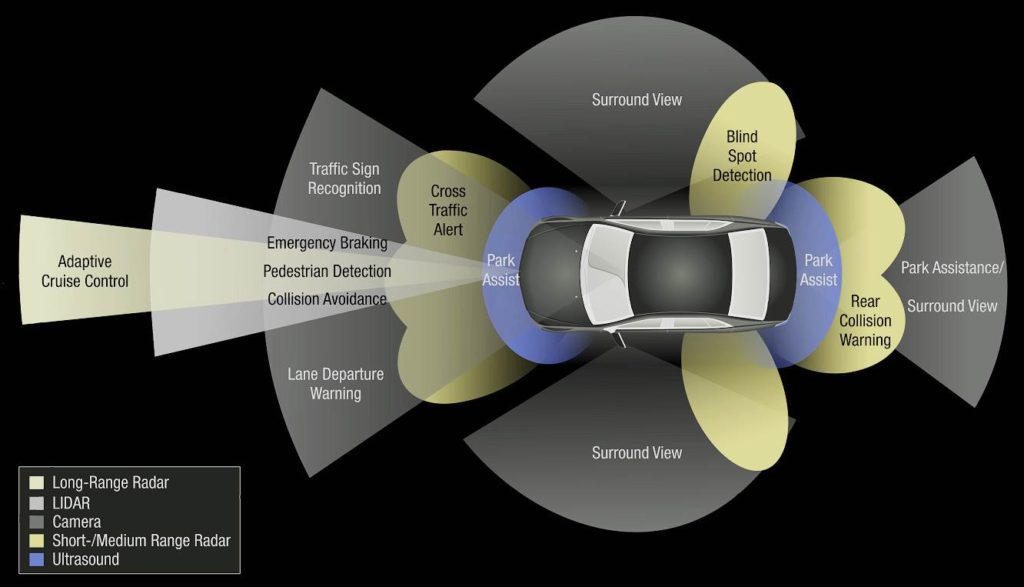
What is ADAS?
ADAS stands for “Advanced Driver-Assistance Systems” and are features in a vehicle that are designed to assist the driver in driving tasks. Some examples of ADAS features include automatic emergency braking, forward-collision warning, blind-spot warning, rear-cross traffic warning, rear automatic emergency braking, adaptive cruise control, lane departure warning, and lane keep assist among others.
ADAS features can help to increase the safety of your vehicle. For example, automatic emergency braking can help to reduce the risk of a collision by automatically applying the brakes if the system detects that a collision is imminent.
ADAS features can also improve the overall driving experience by making it more convenient and comfortable for the driver. Adaptive cruise control can help the driver maintain a safe following distance from the vehicle ahead, and lane departure warning can alert the driver if they start to drift out of their lane.
Additionally some insurance companies offer discounts on premiums for vehicles with ADAS features, as they can help reduce the risk of accidents.
How long does ADAS last in your vehicle?
The lifespan of Advanced Driver Assistance Systems (ADAS) technologies in a vehicle can vary depending on a number of factors, including the specific technology used, the vehicle’s make and model, and the conditions in which the vehicle is used. Some ADAS technologies, such as lane departure warning and blind spot monitoring, may have a longer lifespan than others, like automatic emergency braking and adaptive cruise control, which may require more frequent maintenance or replacement. In general, it is important to follow the manufacturer’s recommended maintenance schedule for your vehicle, which should include any required maintenance for ADAS technologies. This will help ensure that your ADAS technologies are functioning properly and providing the intended level of assistance and protection for as long as possible.
Learn More About ADAS Service and Calibration Here!!
Does ADAS drive for you?
Advanced Driver Assistance Systems (ADAS) are designed to assist drivers, and NOT to drive the vehicle for them. ADAS technologies use a combination of sensors, cameras, and other advanced technologies to monitor the vehicle’s surroundings and provide assistance to the driver in various situations. For example, lane departure warning systems can alert the driver if the vehicle begins to drift out of its lane, while adaptive cruise control systems can adjust the vehicle’s speed to maintain a safe following distance from other vehicles. However, ADAS technologies do not have the ability to take control of the vehicle or make driving decisions on its own. It is important for drivers to remain attentive and in control of their vehicles at all times, even when using ADAS technologies.
Will my insurance cover ADAS?
It is possible for insurance to cover Advanced Driver Assistance Systems (ADAS) technologies, depending on the specific policy and the circumstances of the claim. Some insurance companies may offer coverage for ADAS technologies as part of a comprehensive or optional car insurance policy, while others may exclude coverage for these technologies. It is important to review your insurance policy carefully to understand what is and isn’t covered. If you are considering purchasing a vehicle with ADAS technologies or adding ADAS technologies to your existing vehicle, you may want to contact your insurance provider to determine if these technologies are covered under your policy. In general, it is a good idea to discuss any changes to your vehicle or coverage with your insurance provider in advance to ensure that you have the protection you need.
Are there any disadvantages to installing Advanced Driver Assistance Systems (ADAS) technologies in your vehicle?
Cost: One downside to ADAS is that it can be costly to purchase and install, especially if it is not included as standard equipment on the vehicle.
Complexity: ADAS technologies can be complex and may require special training or expertise to use and maintain. This can make it more challenging for some drivers to fully utilize the benefits.
Reliability: Like any technology, ADAS systems can sometimes malfunction or fail. This can potentially compromise the safety and effectiveness of the system.
False positives: Some ADAS technologies, such as collision warning systems, can generate false positives, meaning they may issue an alert even when no actual danger is present. This can be frustrating or distracting for drivers.
Dependence: Some drivers may become overly reliant on ADAS technologies and may not pay as much attention to their driving. It is important for drivers to remain attentive and in control of their vehicles at all times, even when using ADAS technologies.
Why Choose Auto Glass Professionals for your ADAS Service?
- 100% Certified Technicians
- Latest Technology
- Family Owned
- More than 20+ Years in Auto Industry